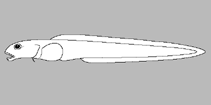Bothrocara nyx Stevenson & Anderson, 2005
Add your observation in Fish WatcherAquaMaps webservice down at the moment
Upload your photos and videos
Google imageNo image available for this species;
drawing shows typical species in Zoarcidae.
Google imageNo image available for this species;
drawing shows typical species in Zoarcidae.
Classification / Names Common names | Synonyms | Catalog of Fishes(genus, species) | ITIS | CoL | WoRMS | Cloffa
Teleostei (teleosts) > Perciformes/Zoarcoidei (Eelpouts and pricklebacks) > Zoarcidae (Eelpouts) > Lycodinae
Etymology: Bothrocara: Greek, bostrykos = cure of lack of hair + Tupí, guaraní, acará = the name of a fish. It could be also from Greek, kara = face (Ref. 45335); nyx: Named for the Greek goddess of night and darkness; noun in apposition. It alludes ot the dark conditions prevalent in the deep waters and northern latitudes where this species occurs, and to the heavily pigmented lining of the mouth and visceral cavity.
Eponymy: Nyx was the goddess of night and darkness in Greek mythology. [...] (Ref. 128868), visit book page.
Etymology: Bothrocara: Greek, bostrykos = cure of lack of hair + Tupí, guaraní, acará = the name of a fish. It could be also from Greek, kara = face (Ref. 45335); nyx: Named for the Greek goddess of night and darkness; noun in apposition. It alludes ot the dark conditions prevalent in the deep waters and northern latitudes where this species occurs, and to the heavily pigmented lining of the mouth and visceral cavity.
Eponymy: Nyx was the goddess of night and darkness in Greek mythology. [...] (Ref. 128868), visit book page.
Environment: milieu / climate zone / depth range / distribution range Ecology
Marine; bathypelagic; depth range 790 - 1508 m (Ref. 56148). Temperate
Distribution Countries | FAO areas | Ecosystems | Occurrences | Point map | Introductions | Faunafri
Northeast Pacific: Eastern Bering Sea.
Size / Weight / Age
Short description Identification keys | Morphology | Morphometrics
Dorsal soft rays (total): 103 - 112; Anal soft rays: 89 - 99; Vertebrae: 108 - 116. Diagnosis: Vertebrae 17 - 19 + 90 - 98 = 108 - 116. Pectoral fin rays 12 - 15. Vomerine teeth 0 - 3. Gill rakers moderately long, 23 - 27. Short snout, less than eye-diameter. Median occipital pore present. Lateral line is not visible on the body. Interior of mouth darkly pigmented (Ref. 56148).
Known from the upper continental slope (Ref. 56148).
Life cycle and mating behavior Maturity | Reproduction | Spawning | Eggs | Fecundity | Larvae
Main reference
Upload your references | References | Coordinator | Collaborators
Stevenson, D.E. and M.E. Anderson, 2005. Bothrocara nyx: a new species of eelpout (Perciformes: Zoarcidae) from the Bering Sea. Zootaxa 1094:53-64. (Ref. 56148)
CITES
Not Evaluated
Threat to humans
Harmless
Human uses
FAO - Publication: search | FishSource |
More information
Trophic ecology
Food items
Diet composition
Food consumption
Food rations
Predators
Food items
Diet composition
Food consumption
Food rations
Predators
Ecology
Ecology
Ecology
Population dynamics
Growth parameters
Max. ages / sizes
Length-weight rel.
Length-length rel.
Length-frequencies
Mass conversion
Recruitment
Abundance
Growth parameters
Max. ages / sizes
Length-weight rel.
Length-length rel.
Length-frequencies
Mass conversion
Recruitment
Abundance
Life cycle
Reproduction
Maturity
Maturity/Gills rel.
Fecundity
Spawning
Spawning aggregations
Eggs
Egg development
Larvae
Larval dynamics
Reproduction
Maturity
Maturity/Gills rel.
Fecundity
Spawning
Spawning aggregations
Eggs
Egg development
Larvae
Larval dynamics
Anatomy
Gill area
Brain
Otolith
Gill area
Brain
Otolith
Physiology
Body composition
Nutrients
Oxygen consumption
Swimming type
Swimming speed
Visual pigments
Fish sound
Diseases & Parasites
Toxicity (LC50s)
Body composition
Nutrients
Oxygen consumption
Swimming type
Swimming speed
Visual pigments
Fish sound
Diseases & Parasites
Toxicity (LC50s)
Genetics
Genetics
Heterozygosity
Heritability
Genetics
Heterozygosity
Heritability
Human related
Aquaculture systems
Aquaculture profiles
Strains
Ciguatera cases
Stamps, coins, misc.
Aquaculture systems
Aquaculture profiles
Strains
Ciguatera cases
Stamps, coins, misc.
Tools
E-book | Field guide | Length-frequency wizard | Life-history tool | Point map | Classification Tree
| Catch-MSY |
Special reports
Download XML
Internet sources
AFORO (otoliths) | Aquatic Commons | BHL | Cloffa | BOLDSystems | Websites from users | Check FishWatcher | CISTI | Catalog of Fishes: genus, species | DiscoverLife | ECOTOX | FAO - Publication: search | Faunafri | Fishipedia | Fishtrace | GenBank: genome, nucleotide | GloBI | Google Books | Google Scholar | Google | IGFA World Record | MitoFish | Otolith Atlas of Taiwan Fishes | PubMed | Reef Life Survey | Socotra Atlas | Tree of Life | Wikipedia: Go, Search | World Records Freshwater Fishing | Zoobank | Zoological Record
Estimates based on models
Preferred temperature (Ref. 123201): 2.7 - 3.1, mean 3 °C (based on 8 cells).
Phylogenetic diversity index (Ref. 82804): PD50 = 0.5039 [Uniqueness, from 0.5 = low to 2.0 = high].
Bayesian length-weight: a=0.00120 (0.00058 - 0.00248), b=3.10 (2.91 - 3.29), in cm total length, based on LWR estimates for this (Sub)family-body shape (Ref. 93245).
Trophic level (Ref. 69278): 3.4 ±0.4 se; based on size and trophs of closest relatives
Resilience (Ref. 120179): Low, minimum population doubling time 4.5 - 14 years (Preliminary K or Fecundity.).
Fishing Vulnerability (Ref. 59153): Low vulnerability (16 of 100).




